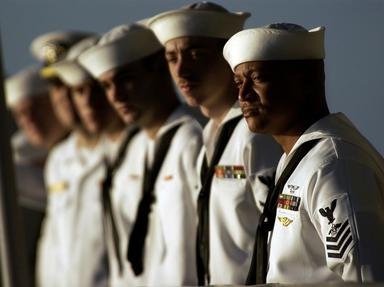Quiz Answer Key and Fun Facts
1. The sleek supersonic F-14 Tomcat can look quite ungainly when on its final approach to the carrier and has earned what seemingly uncomplimentary, but affectionate nickname?
2. The twin engined turboprop powered E-2C Hawkeye airborne surveillance aircraft with the rotating "saucer" atop the fuselage has earned what nickname?
3. Likewise, the twin-engined turbofan powered S-3B Viking makes a rather unique sound when taxiing which led to a nickname and wearing of what patch by many S-3 aviators?
4. Aircraft configured for aerial refuelling mission (this includes the S-3 and F/A-18E/F as well as the A-7 and A-6 in the past) are universally called what generic name, which is also sometimes worn as a patch by some aviators who routinely fly this mission?
5. While the commanding officer of a ship is called the "captain" regardless of rank, in the case of an aircraft carrier, the captain wears the rank of a Naval Captain as well. Aviators do render proper deference to the "Captain" who is always a Naval Aviator (or Flight Officer), but they do not refer to the aircraft carrier as a ship, instead preferring to call it a what?
6. The deck below the flightdeck is home to the Ready Rooms for the individual squadrons embarked in a carrier. When aviators refer to the flightdeck, they also typically use an affectionate term for it.
7. OK, I just about gave away the last one. Here's another softball if you are in the groove now. Landing aboard the carrier and catching a wire with a tailhook is referred to by what term by aviators?
8. Can you feel the pitch of the deck and the salt spray in your nostrils yet? Ready for more? When a fixed wing aircraft is on final approach, what radio call is required at three quarters of a mile (assuming the boat is not under emiissions control/Ziplip conditions)?
9. Now a straight-forward and short one. One of the favorite items for consumption in the wardroom comes out of the soft ice cream machine, which has earned a special nickname for what comes spiraling out. What is it?
10. Chow time is almost over, but not yet. Now we are in the territory of the "Dirty Shirt" wardroom where aviators can partake their meals in flight suits (as opposed to the more formal wardroom where more formal rules and uniform apply....typically aviators ignore that mess and take over the "dirty shirt" mess as their own). What's aviator slang for a hamburger?
11. After pounding down lunch, it's time to climb into the island and stand a watch in the "tower" as your squadron's representative during the next event's landing and take-off. Your duties are to observe and record your squadron's landing interval and respond to the air department head if there are emergencies or issues. What is your duty called?
12. As you enter the tower, a large fellow in a yellow shirt (with a booming voice that rivals a drill sergeant) is sitting in a barber type chair in a commanding position in his own greenhouse arrangement so he can see the maximum amount of flightdeck. He is the head of the Air Department and his rank (usually a captain) is never used. To the air department that he oversees and to all aviators on the ship, he is the voice which must be instantly obeyed. He is known conversationally and over the radio as who?
13. The Landing Signal Officer also has earned a familar term of address for use on the radio and in person. What is it?
14. Now that the LSO no longer has to signal corrections by waving of arms, what key tool is constantly in hand and raised over the head at the beginning of a pass?
15. While all this action is taking place on the flightdeck, there is no room for spectators with all aircraft moving with the jet blast and intakes making it a pretty hazardous place to be without proper training and protective equipment. There is one place where spectators can and often watch flight operations safely out of the way. It is affectionately called:
16. Watching flight operations is like observing a grand orchestration of sights and sounds with life in the balance. Flight deck personnel all wear color coded jerseys to signify their specialized assignments and duties. Sailors assigned to handle the fueling hoses wear purple and are referred to as:
17. The Traffic cops of the flight deck wear yellow jerseys. Before take-off and after landing, no pilot moves his aircraft unless under the direction of a yellow-shirted flight deck director who use hand signals to direct the movement of the aircraft. They are known as:
18. Naval Aviation Aircraft fuel gauges are calibrated in:
19. During daylight operations, aircraft return to the carrier without radio communications and set up orbits in a tangental counter clockwise motion above the carrier with different type aircraft proceeding to prebriefed altitudes while awaiting their turn to land. This orbiting collection of aircraft is called the:
20. If an aircraft arrives before the flightdeck is ready for landing it is waved off because the deck is considered to be:
Source: Author
heyjoe54
This quiz was reviewed by FunTrivia editor
Stillman before going online.
Any errors found in FunTrivia content are routinely corrected through our feedback system.


